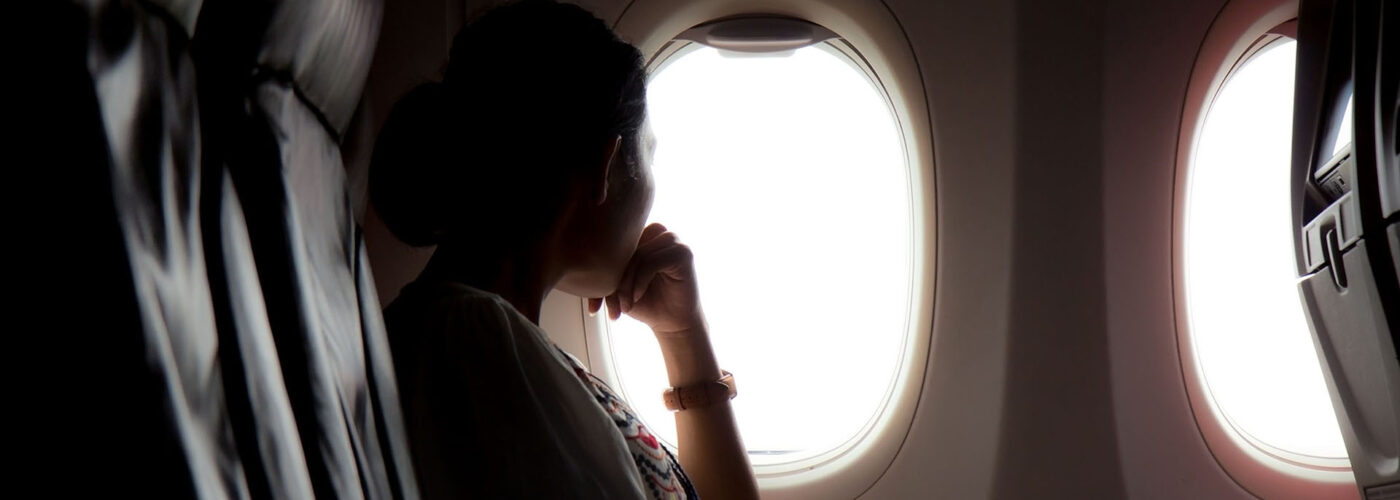Many people love traveling and seeing new places, but there’s one part of travel that isn’t so fun: flying. For some, flying is simply a hassle, thanks to high fares, flight delays, and lost luggage. But for other travelers, flying is more than inconvenient; it’s terrifying.
Fear of flying can be caused by a number of factors, including claustrophobia or a fear of heights. Many nervous flyers feel irrational anxiety that their plane will malfunction and crash, no matter how many times they hear the statistics about how safe flying is compared to driving. Other travelers worry about terrorist hijackings or panic at the idea that they’re not in control of the aircraft that’s carrying them.
No matter why you’re scared of flying, there are certain steps you can take to help alleviate your fears. To fly or not to fly is a personal decision, and one that no one else can make for you. But for those of you who are determined not to let this change your way of life, below are a few tips for overcoming your fear of flying.
Before Your Trip
Know What to Expect
For many fearful flyers, learning the basics of how airplanes work can go a long way toward alleviating their anxiety. For instance, understanding how a plane can continue to fly even if an engine fails can help you feel less concerned about your aircraft malfunctioning. GuidetoPsychology.com offers an easy-to-understand explanation of how planes stay in the air, what causes turbulence, and what’s behind those scary sounds during takeoff and landing.
Dr. Margaret Wehrenberg, PsyD, a licensed clinical psychologist and author of The Anxious Brain and The 10 Best-Ever Anxiety Management Techniques, recommends asking yourself: “What is the catastrophe? What do I actually think will happen? What am I making a big deal out of? … Answer these questions before you get on the plane.”
Familiarize Yourself with Your Plane
Getting to know what your plane looks like can make it seem a little less scary. I once heard of a fearful flyer who actually put a picture of the plane’s cabin on her computer’s desktop; by the time her flight rolled around, the image was familiar, not scary.
Choose an Aisle Seat
Most airlines and booking engines allow you to request a seat assignment when you book your flight. Request an aisle seat, particularly if you’re prone to claustrophobia; you’ll feel less hemmed in by other people, and you’ll be able to get up and move around the cabin more easily. This also makes it easier to avoid looking out the window if those sky-high views make you nervous. (For more information on nabbing the seat you want, see 10 Ways to Get the Best Airplane Seat.)
Monitor Your Media Intake
This may seem like a no-brainer, but it’s worth mentioning: Avoid airplane disaster movies, news coverage of plane crashes, or other scary media images. Remember that the vast majority of flights arrive safely, but only the problem flights make the news. Don’t let that skew your impressions of flying.
Think Positive
In the days leading up to your trip, it’s easy to let the flight anxiety build. When this happens, counter your fear of flying with the exciting prospect of getting to be on a plane, hopefully going somewhere fun. Try to focus on the positive—like all the things you’ll do once you reach your destination.
At the Airport
Don’t Rush
Allow yourself plenty of time to get to the airport before your flight is scheduled to depart. Racing to the gate and worrying about missing your plane will only add to your anxiety. For more advice, see How Early Should I Get to the Airport?
Wait for Your Flight in an Airport Lounge
Most airlines have private airport lounges that are quiet, luxurious oases away from the hustle and bustle of the rest of the airport. While they’re usually reserved for club members or elite flyers, you can often purchase a day pass for about $50—which may be a small price to pay for a soothing place to relax and prepare for your flight.
On the Plane
Meet the Crew
If there’s time before your flight, ask to meet the pilot of your plane. Alternatively, spend a minute or two chatting with a flight attendant. Often, meeting the folks who hold your safety in their hands can make the plane seem like a friendlier environment and reassure you that that crew is knowledgeable and competent.
Tune In
Make sure your phone or tablet is stocked with soothing music to help get you into a peaceful frame of mind. You may also want to download stress-busting meditation or instructional breathing sessions from an app such as Headspace (iOS | Android) or Simple Habit (iOS | Android) so you can listen to them when your phone is in airplane mode.
Remind Yourself Who’s in Charge
Many anxious flyers are bothered by their perceived lack of control since they have no influence over the safety or performance of the aircraft. Try to regain a little control by reminding yourself that you made the decision to fly and that you can decide how you respond to the experience.
Breathe
As anxiety increases, your breathing may get shallow—but deep, conscious breathing is an instant stress reliever. Breathe slowly and deeply for a count of five or 10, in through your nose and out through your mouth.
Although this bit of advice may seem obvious, breathing is arguably the best way to vanquish anxiety. Dr. Wehrenberg explains that controlled breathing works because “breathing is the one thing that will stop a panic attack.”
Turning on the air vents above your head, leaning back, and closing your eyes may help you feel less claustrophobic. Sniffing a lavender sachet or sucking on a peppermint are other calming, meditative tricks.
Read or Watch Something Fun
Pack a magazine, a good book, or a puzzle to take your mind off what’s happening. Order up a comedy on your plane’s in-flight entertainment system, or preload a few of your favorite flicks onto your laptop. Be sure to stock up on activities that will last you the duration of your flight and that you can continue to enjoy when it’s time to turn electronic devices off.
Have a Drink
Many nervous flyers turn to alcohol to calm their nerves. While this may be fine in moderation, keep in mind that alcohol should not be combined with anti-anxiety medications. Also, alcohol can contribute to dehydration, particularly in the arid environment of an airplane. If you do treat yourself to a cocktail, be sure to follow it up with plenty of water.
Avoid Caffeine
This and other stimulants can make you even more jittery.
Go with the Flow
Recognize that panic is temporary, and that it will pass. If you feel afraid of losing control and succumbing to fear during the flight, remind yourself that even a full-on panic attack is only a temporary affliction; you’ll get through it.
More Fear of Flying Help
Pop a Pill
If your fear is particularly debilitating and you’ve tried other relaxation techniques without success, ask your doctor if it may be worth taking an anti-anxiety medication or a sleeping pill before you fly.
Contact a Professional
How do you know when it’s time to make an appointment with a medical professional? Says Dr. Wehrenberg, “If you’re losing sleep, feeling sick with anxiety, or avoiding travel at the expense of your own or other people’s convenience,” a licensed therapist or counselor can help you figure out the root causes of your fear and how to overcome them.
Go Online
There are a number of special programs and websites that offer tips for nervous flyers. Here are a few to try:
- SOAR offers free tips, newsletters, chats, and videos, as well as more comprehensive counseling and programs for a fee.
- Anxieties.com offers a free online self-help program for those who want to overcome their fear of flying.
- GuidetoPsychology.com is a comprehensive site with information about how airplanes work and tips for how to get over your fear of flying.
- Valk (iOS | Android) is a fear of flying app that serves as an “in-flight therapist,” including facts about flying and even a panic button you can hit to get in-the-moment support in airplane mode.
More from SmarterTravel:
- 10 Ways to Survive a Long-Haul Flight
- Hate Airplane Turbulence? Here’s How to Know When It Could Strike
- Airport Security Frequently Asked Questions
Follow Sarah Schlichter on Twitter @TravelEditor for more travel tips and inspiration.
Editor’s note: This story was originally published in 2017. It has been updated to reflect the most current information. Caroline Costello and Margaret Leahy contributed to this story.
You Might Also Like:
• 5 Apps You Need for COVID Travel• Airport Security Frequently Asked Questions
• The 9 Best CBD Products for Travel
• New COVID-19 Travel Rules Announced for All Flights Into the U.S.
• 15 Tips for Traveling Safely During COVID-19
We hand-pick everything we recommend and select items through testing and reviews. Some products are sent to us free of charge with no incentive to offer a favorable review. We offer our unbiased opinions and do not accept compensation to review products. All items are in stock and prices are accurate at the time of publication. If you buy something through our links, we may earn a commission.
Related
Top Fares From
Today's Top Travel Deals
Brought to you by ShermansTravel
4-Night Grand Canyon & Las Vegas...
Great Value Vacations
 vacation
$772+
vacation
$772+
Greek Isles: Luxe Last-Minute, 7-Nt, All-Incl....
Regent Seven Seas Cruises
 cruise
$8599+
cruise
$8599+
Asia: Business Class Round-Trip Flights to...
Business-Class
 Airfare
$2249+
Airfare
$2249+




